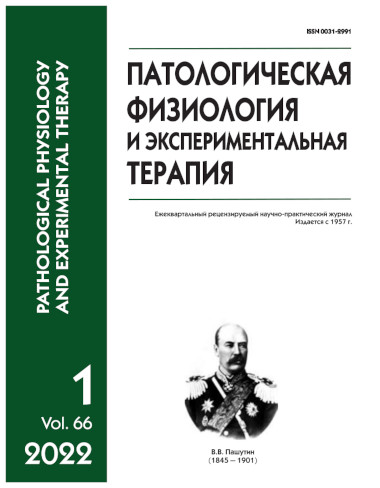Manifestations of hyper- and dehydration of the nervous tissue of the fields CA1 and CA3 of the hippocampus after variable and permanent occlusions of the common carotid arteries
Abstract
Aim. To study structural changes in neuron-glial relationships and to provide a morphometric description of swelling of structures in the CA1 and CA3 fields of the rat hippocampus 1, 3, 7, 14, and 30 days after variable (VOCA) and permanent occlusions (POCA) of the common carotid arteries. Methods. Four groups of sexually mature Wistar rats were studied: group I (30-min unilateral VOCA, n=30), group II (20-min bilateral VOCA, n=30), group III (40-min bilateral VOCA, n=30), Group IV (POCA, n=30). Histological (hematoxylin-eosin and Nissl staining), immunohistochemical (MAP-2, GFAP), and morphometric methods were used. On preparations stained with hematoxylin-eosin, using plug-ins of the ImageJ 1.53 (Find Foci) software, various parameters of brightness and distribution of image pixels were evaluated. Reactions for MAP-2 and GFAP were used for cell verification. Statistical hypotheses were tested with Statistica 8.0 software using nonparametric Shapiro-Wilk W test, Mann-Whitney U test, Wilcoxon Matched Pairs test, Kraskel-Wallis ANOVA, and ROC analysis. Results. After VOCA and POCA, a large number of heteromorphic bright zones of edema swelling appeared in the hippocampus with a high overall pixel intensity at the peak. The maximum number of these zones was noted after POCA during the entire observation period. After VOCA, the degree of neuropil hydration significantly changed (group II, p=0.03; group III, p=0.0003), decreasing after 14 and 30 days of observation. In group I, moderate reversible swelling prevailed, and in groups II, III, and IV, against the background of normochromic neurons, various combinations of swollen, dark, non-wrinkled, and wrinkled processes of dendrites/perikaryons, and edema of the perivascular and near-neuronal processes of astrocytes were evident. As the severity of ischemia increased, signs of hyperhydration of the astrocytic compartment and dehydration of neurons became evident. In groups I, II, and III, functionally significant possibilities for restoration of most of the dark neurons and astroglia remained. After POCA, the mechanisms of fluid outflow through astrocytes were disrupted. Large cavities with free fluid and a destroyed GFAP-positive cytoskeleton were formed. This was accompanied by dysfunction of astrocytes and, as a result, by irreversible dehydration and intravital degeneration of CA1 and CA3 dark neurons (pycnomorphic with homogenization). Conclusion. After VOCA and POCA, the structural and functional reorganization of neurons in the CA1 and CA3 fields of the hippocampus was associated with hyperhydration of the neuropil and the perineuronal and perivascular spaces (peduncles of astrocytes). The extreme degree of variation of these manifestations was noted after POCA, which indicated dysfunction and death of a large number of astrocytes as a result of excessive swelling of their processes near pycnomorphic neurons. In the VOCA groups, prolonged swelling was not accompanied by pronounced, irreversible death of dark neurons. Most of these neurons recovered in parallel with the restoration of astrocytes. Therefore, in the VOCA groups, the persistence of swelling should be considered primarily as a condition for engaging the sanogenesis mechanisms in the nervous tissue, i.e., its detoxification.






